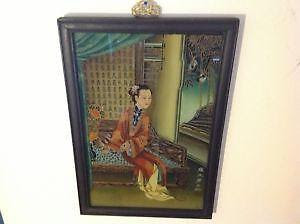Oil or acrylic painting is not limited to just strokes on a canvas. There is another art form called reverse painting that is both fun and challenging to do. It is typically done on a piece of glass and then viewed by reversing the image; thus the term, reverse painting. It is an old art form, although many beginning painters are wary of trying it out. Admittedly the art form requires incredible amounts of diligence as it is generally unforgiving to error. That said, there are a few tips that make the process easier.
Image Source: antiques.com
Do everything backwards: What makes reverse painting difficult at first is that one is doing everything in reverse. As such, the working image is on the back of the glass. Letters or symbols are painted as the mirror image on how they are usually read. Furthermore, accents that would normally be painted last are done first while backgrounds are painted last, where they are usually painted first.
Image Source: ebay.com
Practice on canvas or wood: There is no better teacher than experience. If one is too hesitant to begin on glass immediately, canvas or wood are ideal practice tools. Some painters even use mirrors to see how it would look like when reversed. Each painter has their unique style that would best suit them.
It is also recommended that beginner artists buy small glass frames to start with. This way, they can hold the frame in their hands and constantly adjust their painting as they go. Once they get more comfortable, larger glass frames can be bought.

